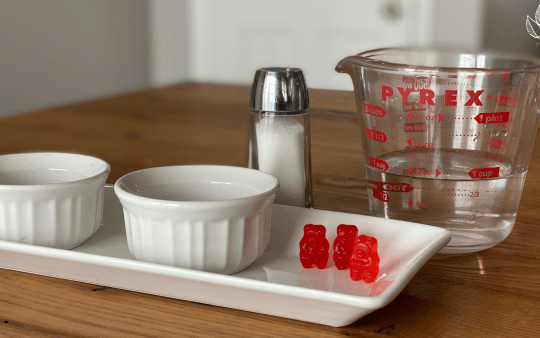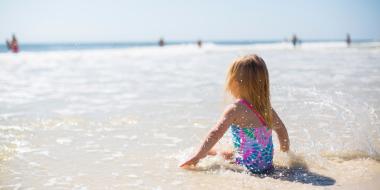Road Salt and the Environment: The Gummy Bear Experiment
Photo courtesy of Jessica Purcell and Medinah Eatman
EcoParent Ambassador and Founder of Thoughtfully Sustainable Jessica Purcell teamed up with Medinah Eatman of Science Teacher Mom to create a virtual class that explains why excess road salt can be hazardous to the environment. They’re sharing their simple experiment with you and your learners in an effort to make the science more accessible!
As we wait patiently for spring to arrive on March 20, the snow and ice continue to make their mark outdoors. This means that, for the safety of pedestrians and drivers, salt is applied to roadways and sidewalks to prevent accidents.
Kelsey Scarfone, Water Program Manager for Environmental Defense, wrote an article in the Winter edition of EcoParent magazine about the dangers of road salt for the flora and fauna in seasonal climate regions. That article inspired me and Medinah Eatman, science teacher and founder of Science Teacher Mom, to create a science lesson to teach young learners about why these dangers exist.
Osmosis and Road Salt
It all starts with the word, osmosis. You may recall hearing this word in your science classes in middle and high school but probably nowhere else. Osmosis is simply the movement of water across a membrane from areas of high concentration to areas of low concentration. It's the way living things keep their water content in balance.
By gathering the supplies listed below, you can demonstrate how this basic biological phenomenon of osmosis works—in the comfort of your kitchen.

The Gummy Bear Experiment
Ingredients:
- 3 gummy bears
- Water
- Table salt
- 3 small bowls or cups
- Teaspoon
- Liquid measuring cup
- Ruler
- Pencil
- A salty snack (popcorn, chips or crisps, etc.)
Please Note: The gummy bears mentioned are the ones found in the candy aisle of your local grocer, not the fruit snack kind. You’ll need the sugar-dense version of this treat for the experiment to work!
Instructions
- First, make some predictions: what will happen to the gummy bear that is placed in water? What will happen to the gummy bear placed in saltwater? Record these predictions on a piece of paper or download a free printable packet for the lesson here.
- Next, measure the length, width and height of each gummy bear and record these as the initial sizes.
- Label your three small bowls or cups: 1) water 2) saltwater 3) control
- Measure a ¼ cup (~60 ml) of water and place it in Cup 1.
- Place one gummy bear in Cup 1 with the water.
- Measure a ¼ cup of water and place it in Cup 2. Add 3 teaspoons of table salt and mix with a spoon until the salt is mostly dissolved.
- Place one gummy bear in Cup 2 with the saltwater solution.
- Place one gummy bear in Cup 3 (this cup will serve as your control).
- Note the time and in 1 hour, check back on the progress of your gummy bears. Have they changed in size?
- After 24 hours, remove each gummy from its cup and measure the length, width and height of each. Did they grow? Did they shrink? Did they remain unchanged?
- Record your observations and check to see if your predictions were accurate!
Remember that predictions are simply educated guesses or hypotheses. They do not need to be accurate to mean that your learners are gaining knowledge!
The Science Behind The Gummy Bear Experiment
Your learners should observe that the gummy will get bigger when it is placed in water. The concentration of particles is much higher inside of the gummy bear, and so the water travels into the candy to attempt to balance out the concentration, thus making the bear absorb water and increase in size, or “grow”.
When the gummy bear is placed in salt water, the opposite should be observed. The concentration of particles in the saltwater solution is higher than the particles inside the gummy bear, and so the water that is in the bear travels out, making the bear decrease in size, or “shrink”. The control gummy should remain unchanged. What you and your learners have observed is the process of osmosis!

How Does the Gummy Bear Experiment Apply to our Environment?
At this point, you can help to solidify the concept of osmosis by asking your learners to eat a few bites of their salty snacks. How does their mouth feel after eating the snack? Are they thirsty?
Osmosis is happening right inside their mouths! The salt in the snack absorbs water from their mouth, making them feel thirsty, or what we commonly refer to as dehydrated. This same concept is used when salt is applied to foods in an effort to preserve them, preventing bacterial growth.
This dehydration process also occurs in the environment when excess road salt washes into local waterways in winter. Freshwater plants cannot tolerate higher concentrations of salt, and as result, will have stunted growth and fewer flowers produced.
Freshwater fish can also be negatively affected by higher salt concentrations. It has been found that trout offspring will be much smaller in size when born in water with increased salinity. Also, the freshwater plankton that lives in these environments cannot tolerate a large increase in salt content and the populations of these vital organisms declines, greatly reducing food sources for resident fish, clams and snails.
Additionally, salt is a vital nutrient for large mammals like deer and moose. In the winter, these animals are attracted to the salt spread on roadways, causing an increase in vehicle collisions and accidents.

Creating Critical Thinkers
By exploring the concept of osmosis with your children, you are not only engaging their minds in the process of critical thinking but also fostering their feelings of responsibility for their environment.
Providing your learners with the mental tools they’ll need to make fact-based decisions are invaluable. These skills can be strengthened by practicing the simplistic steps of the scientific method found in this investigation. If you’d like more science-based activities and experiments, consider subscribing to a free newsletter from Thoughtfully Sustainable and Science Teacher Mom or check out their informative content on social media.
To access a video of this virtually taught lesson, click here. If you’d like to download a free printable packet to accompany this lesson, you can access it here.

You may also enjoy: 3 Sustainability Science Experiments for the Holiday Season, Nature Adventures in Your Own Backyard, and How Wild Seeds Disperse.






